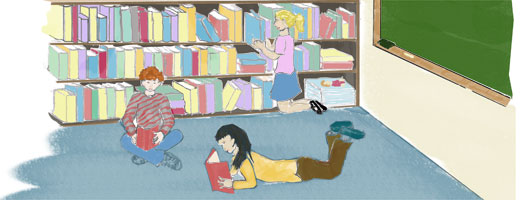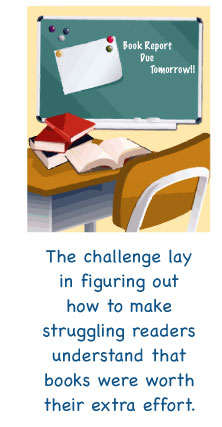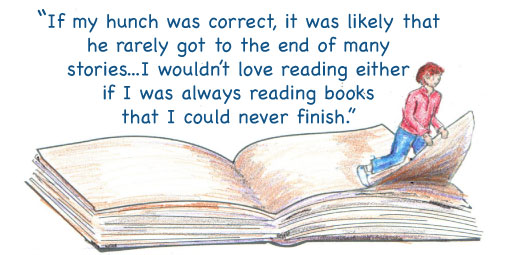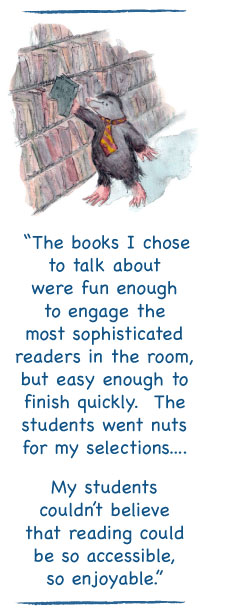Creating a Reading Culture
By Kyle Redford


I’ll admit I used to wonder if my dyslexic students were doomed to always consider reading a chore. It was a logical concern; how could something so labored ever engender fondness? But I knew most of these students loved to listen to stories and I couldn’t help but wonder if they might also possess an untapped love for reading independently. The challenge lay in figuring out how to make struggling readers understand that books were worth their extra effort.
 Then I stumbled upon a simple observation that gave me an idea—and lots of hope.
Then I stumbled upon a simple observation that gave me an idea—and lots of hope.
It all started when I hired a colleague of mine, Meg, to work with my dyslexic son on his writing the summer before he entered high school. Like any good writing teacher, his summer tutor understood the intimate connection between reading and writing. Meg arrived at our home loaded down by bags of books and full of lots of questions. She immediately launched into a detailed interview of my son to determine what kinds of things he liked to read.
“I thought we were going to work on my writing?” my son inquired as politely as he could. Meg explained that before they started to work on his writing, she wanted him to think about what kinds of writers he liked to read. This would help him develop his own voice as a writer.
He was immediately stumped. Writers he liked? Favorite books? Reading books was something he had to do for school. It certainly was not something he did for pleasure. Beyond listening to his parents read him stories, my son had not spent a lot of time considering books or the writers who wrote them. Meg anticipated his blank response and proceeded to pull a large pile of humor books out of her bag. “Read these before we meet again on Friday.”
I was shocked. Not only was the expectation of reading a stack of books out of whack for a student with dyslexia, but the books she pulled out of her bag were for elementary school students; Diary of a Wimpy Kid? Love that Dog? A stack of simple picture books? What was she thinking? I could already anticipate my son’s surly and dismissive reaction once his tutor left us alone. After all, he was entering high school in two months and he needed to learn how to improve his writing skills, not waste his precious time revisiting children’s books.
After Meg left, my son quietly lugged the stack of books upstairs without complaint. I kept quiet. The next day he announced that he had finished the books, “Done. They were really easy.” That’s all.
Meg came back a few days later. Again, she had more books and questions for my son. When she asked him what he thought of the books she had lent him, he offered very detailed and thoughtful responses. In fact, he sounded more like a professional book critic than a kid who never read unassigned books. Who knew? Then Meg asked him if he knew any comedic writers that he would like to read over the summer. Yes, in fact he did: David Sedaris. His dad had read him some short stories from The New Yorker.
My son’s next assignment was to look through all of our back issues of The New Yorker and read as much David Sedaris as possible before the next week. From picture books to The New Yorker in one short week? I privately winced and waited for her to leave. Again, I was sure that my son would complain that Meg’s expectations were out of line.

But no. Meg left, and once again he headed upstairs to do his summer homework. This time when I walked by his open door, he was busy reading on his bed surrounded by a mess of old magazines. He continued to read and read The New Yorker over the next few days before she returned for their next meeting. This time his opinions about David Sedaris’s short stories were very clear and strong. He knew which stories worked for him, and which stories he thought were weaker. He could also explain why. My dyslexic critic was now thoughtfully analyzing The New Yorker. I had to think about this.
I was witnessing a change so profound and rapid in my son that it made me wonder how I could co-opt this magic for the dyslexic and struggling readers in my own class. I could tell by my conversations with Meg that she didn’t fully understand herself what she saw happening with him. I was going to have to use my “teacher knowledge” and my mother instincts to deconstruct this transformation.
My initial, albeit depressing, hunch was that my son hadn’t finished many books on his own before. With so much pressure to have the appropriate title in his hand during quiet reading time at school, he was probably engaged in a lot of posturing. I could easily imagine him worried that his peers and teachers might think his books immature. He had most likely been wasting a lot of time faking engagement with the wrong books. If my hunch was correct, it was likely that he rarely got to the end of many stories.
How does one ever develop a passion for reading if one never finishes a story? Stories are written to be read: beginning, middle, and end. If an interruption is always taking place, no appreciation for the architecture of a story can be developed. I wouldn’t love reading either if I was always reading books that I could never finish.
My first mission: I must get my students to read easier books.
But how does one get students to read easier books in a culture where one’s academic stock is directly determined by the reading level of the book in one’s hands? I had to figure out a way to lure my students to the appropriate level of book.
I decided to try an experiment. It involved encouraging everyone in my class to “read down.” When I introduced my class library in the fall, I planned to sell my students very compelling but easy books. In fact, I decided to hide all the harder books in a secret cupboard in the room and fill the newly freed space with the easier titles.
I read dozens and dozens of easy Middle Reader fiction books that summer so I would know the material and be able to make successful recommendations to the students. Then I scoured used books stores and garage sales so that our class library would be appropriately stocked when my students arrived back to school.
It worked.

It worked almost immediately. Of course, I never called them easy books when I introduced my favorites to the class. Instead, I just reset the expectations in the classroom by focusing on a different kind of book. The books I chose to talk about were fun enough to engage the most sophisticated readers in the room, but easy enough to finish quickly. The students went nuts for my selections. Some were graphic novels; others were poetic prose; many were simply well-written short books. My students couldn’t believe that reading could be so accessible, so enjoyable.
Students started to beg for quiet reading time. They asked to bring the class library books home. They shared our books with friends in other classrooms. They made waitlists for the most popular titles. They solicited additional suggestions of books by their new favorite authors. They talked about books with their friends. They started visiting bookstores and libraries. They donated new books to our class shelves. I had never seen anything like it. In fact, as a teacher, I realized that I had started to spend much of my instructional time talking to students about what their next book should be and what they thought of their last. Reading had acquired an urgency that it never had before.
What had initially started out as an experiment to get my struggling readers to enjoy books had turned my entire class into a culture of passionate readers. My assumptions and behaviors as a teacher also changed. I completely rethought how I talked about books in my class, and I kept current on all the newly released titles. The students started to talk to each other about books. As a class, we spent more and more time reading and talking about what we read. My struggling readers were equals in these conversations. They knew as well as their peers what they liked in a story, and the more they practiced talking about books, the better they got at explaining their opinions. There was no more false puffery associated with the difficulty level of their books. The new, more relevant questions were, “Is the book any good? and, “Do you think I would like it?”
Later, I slipped the more difficult books back onto our shelves. All the students were making rapid progress with their reading, their reading appetites were growing, and literary curiosity in the classroom was exploding. Our class library now offered a little something for everyone.

Click Here for “Creating a Classroom Reading Culture” Reading List
Addendum: My son now reads Kurt Vonnegut and the classic philosophers for pleasure. Needless to say, I owe a lot to THE DIARY OF A WIMPY KID.
updated 11/16/2011
Related
Math: Processing Breakdowns
Students with slower processing speeds or executive-function problems are often no different from their peers in math proficiency in first and second grade; but as they confront multistep computations in upper elementary school tests, their scores tumble because they lack the skills necessary to produce organized, efficient output.
Read MoreMath: Naming Problems
Math-specific concepts seem to be particularly difficult to master. In addition to being abstract, these concepts contain terms that confound students with visual similarity or auditory similarity between homophones.
Read More
Math: Memory Challenges
Often an educational evaluation will describe a dyslexic student as having “low working memory.”
Read More
Math: Counting & Comparing
A common response to students who are having counting problems is to simply have them do daily counting practice; however, students with counting and comparing difficulties also benefit from practice that utilizes patterns and relationships.
Read More